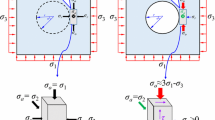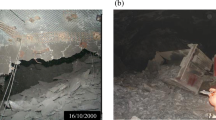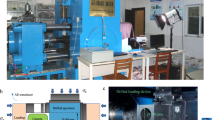Abstract
Strainbursts, which are violent disasters that are accompanied by the ejection failure of rocks, usually occur in hard brittle rocks around highly stressed underground openings. The release of the radial stress at excavation boundaries is one of the major inducing factors for strainbursts in tunnels. After excavation, the radial stress usually exhibits different but apparent gradient variations along the radial direction near the boundary within a certain depth under different in situ stress conditions. In this study, the influence of the radial stress gradient on strainbursts of granite was investigated using an improved true-triaxial rockburst testing system, which was equipped with an acoustic emission monitoring system. The stress state and boundary conditions (i.e., one face free, other faces loaded and increasing tangential stress) of the representative rock element in the vicinity of the excavation boundary were simulated. High-speed cameras were used to capture the ejection failure processes during strainbursts, and the kinetic energy of ejected fragments was quantitatively estimated by analyzing the recorded videos. The experimental results indicate that with an increasing radial stress gradient, the strength increases, the apparent yield platform prior to the peak stress on the stress–strain curves decreases, the failure mode changes from strainburst characterized by tensile splitting to strainburst characterized by shear rupture, and the kinetic energy of ejected fragments during strainbursts significantly increases.


















Similar content being viewed by others
References
Alejano LR, Alonso E (2005) Considerations of the dilatancy angle in rocks and rock masses. Int J Rock Mech Min Sci 42:481–507
Bear J (1972) Dynamics of fluids in porous media. Elsevier, New York
Berry JP (1960) Some kinetic considerations of the Griffith criterion for fracture—I. J Mech Phys Solids 8:194–206
Bobet A, Einstein HH (1998) Fracture coalescence in rock-type materials under uniaxial and biaxial compression. Int J Rock Mech Min Sci 35:863–888
Cai M (2008) Influence of intermediate principal stress on rock fracturing and strength near excavation boundaries—insight from numerical modeling. Int J Rock Mech Min Sci 45:763–772
Cai M (2013) Principles of rock support in burst-prone ground. Tunn Undergr Space Technol 36:46–56
Chang SH, Lee CI (2004) Estimation of cracking and damage mechanisms in rock under triaxial compression by moment tensor analysis of acoustic emission. Int J Rock Mech Min Sci 41:1069–1086
Chen JT, Feng XT (2006) True triaxial experimental study on rock with high geostress. Chin J Rock Mech Eng 25:1537–1543
Chen WZ, Lu SP, Guo XH, Qiao CJ (2009) Research on unloading confining pressure tests and rockburst criterion based on energy theory. Chin J Rock Mech Eng 28:1530–1540
Cook NGW (1965a) The failure of rock. In: International journal of rock mechanics and mining sciences and geomechanics abstracts, vol 2, pp 389–403
Cook NGW (1965b) A note on rockbursts considered as a problem of stability. J South Afr Inst Min Metall 65:437–446
Cuisiat FD, Haimson BC (1992) Scale effects in rock mass stress measurements. In: International journal of rock mechanics and mining sciences and geomechanics abstracts, vol 29, pp 99–117
Diederichs MS (2007) The 2003 Canadian Geotechnical Colloquium: mechanistic interpretation and practical application of damage and spalling prediction criteria for deep tunnelling. Can Geotech J 44:1082–1116
Dyskin AV, Germanovich LN (1993) Model of rockburst caused by cracks growing near free surface. In: Young P (ed) Rockburstsand seismicity in mines 93. Balkema, Rotterdam, pp 169–175
Eberhardt E (2001) Numerical modelling of three-dimension stress rotation ahead of an advancing tunnel face. Int J Rock Mech Min Sci 38:499–518
Ewy RT, Cook NGW (1990) Deformation and fracture around cylindrical openings in rock—I. Observations and analysis of deformations. In: International journal of rock mechanics and mining sciences and geomechanics abstracts, vol 27, pp 387–407
Fairhurst C, Cook NGW (1966) The phenomenon of rock splitting parallel to the direction of maximum compression in the neighborhood of a surface. In: Proceedings of the first congress on the international society of rock mechanics, Lisbon, pp 687–692
Feng XT, Chen BR, Zhang CQ, Li SJ, Wu SY (2013) Mechanism, warning and dynamic control of rockburst development processes. Science Press, Beijing
Feng XT, Zhang XW, Kong R, Wang G (2016) A novel mogi type true triaxial testing apparatus and its use to obtain complete stress–strain curves of hard rocks. Rock Mech Rock Eng 49:1649–1662
Germanovich LN, Dyskin AV (2000) Fracture mechanisms and instability of openings in compression. Int J Rock Mech Min Sci 37:263–284
Gong QM, Yin LJ, Wu SY, Zhao J, Ting Y (2012) Rock burst and slabbing failure and its influence on TBM excavation at headrace tunnels in Jinping II hydropower station. Eng Geol 124:98–108
Gong WL, Peng YY, Wang H, He MC, e Sousa LR, Wang J (2015) Fracture angle analysis of rock burst faulting planes based on true-triaxial experiment. Rock Mech Rock Eng 48:1017–1039
Haimson B (2006) True triaxial stresses and the brittle fracture of rock. Pure Appl Geophys 163:1101–1130
Haimson B (2007) Micromechanisms of borehole instability leading to breakouts in rocks. Int J Rock Mech Min Sci 44:157–173
Haimson B, Chang C (2000) A new true triaxial cell for testing mechanical properties of rock, and its use to determine rock strength and deformability of Westerly granite. Int J Rock Mech Min Sci 37:285–296
He MC, Miao JL, Li DL, Wang CG (2007) Experimental study on rockburst processes of granite specimen at great depth. Chin J Rock Mech Eng 26:865–876
He MC, Miao JL, Feng JL (2010) Rock burst process of limestone and its acoustic emission characteristics under true-triaxial unloading conditions. Int J Rock Mech Min Sci 47:286–298
He MC, Jia XN, Coli M, Livi E, Sousa L (2012a) Experimental study of rockbursts in underground quarrying of Carrara marble. Int J Rock Mech Min Sci 52:1–8
He MC, Nie W, Zhao ZY, Guo W (2012b) Experimental investigation of bedding plane orientation on the rockburst behavior of sandstone. Rock Mech Rock Eng 45:311–326
Hedley DGF (1992) Rockburst handbook for Ontario hardrock mines. CANMET Special Report SP92-1E
Hoek E, Martin CD (2014) Fracture initiation and propagation in intact rock—a review. J Rock Mech Geotech Eng 6:287–300
Horii H, Nemat-Nasser S (1985) Compression-induced microcrack growth in brittle solids: axial splitting and shear failure. J Geophys Res 90:3105–3125
Hou ZS, Gong QM, Sun ZH (2011) Primary failure types and their failure mechanisms of deep buried and intact marble at Jinping II Hydropower Station. Chin J Rock Mech Eng 30:727–732
Hua AZ, You MQ (2001) Rock failure due to energy release during unloading and application to underground rock burst control. Tunn Undergr Space Technol 16:241–246
Huang D, Li YR (2014) Conversion of strain energy in triaxial unloading tests on marble. Int J Rock Mech Min Sci 66:160–168
Jaeger JC, Cook NGW, Zimmerman R (2007) Fundamentals of rock mechanics. Blackwell, Hoboken
Jiang Q, Su GS, Feng XT, Cui J, Pan PZ, Jiang JQ (2015) Observation of rock fragment ejection in post-failure response. Int J Rock Mech Min Sci 74:30–37
Kaiser PK, McCreath D, Tannant D (1996) Canadian rockburst support handbook. Geomechanics Research Centre, Sudbury
Kaiser PK, Diederichs MS, Martin CD, Sharp J, Steiner W (2000) Underground works in hard rock tunnelling and mining. Paper presented at the GeoEng2000, Melbourne, Australia, pp 841–926
Kawakata H, Cho A, Kiyama T, Yanagidani T, Kusunose K, Shimada M (1999) Three-dimensional observations of faulting process in Westerly granite under uniaxial and triaxial conditions by X-ray CT scan. Tectonophysics 313:293–305
Kwasniewski M (2012) Mechanical behavior of rocks under true triaxial compression conditions—a review. In: Kwasniewski M, Li X, Takahashi M (eds) True triaxial testing of rocks. CRC Press, Boca Raton, pp 99–138
Lee M, Haimson B (1993) Laboratory study of borehole breakouts in Lac du Bonnet granite: a case of extensile failure mechanism. In: International journal of rock mechanics and mining sciences and geomechanics abstracts, vol 30, pp 1039–1045
Li T, Cai MF, Cai M (2007) A review of mining-induced seismicity in China. Int J Rock Mech Min Sci 44:1149–1171
Li SJ, Feng XT, Li ZH, Chen BR, Zhang CQ, Zhou H (2012) In situ monitoring of rockburst nucleation and evolution in the deeply buried tunnels of Jinping II hydropower station. Eng Geol 137:85–96
Linkov AM (1996) Rockbursts and the instability of rock masses. In: International journal of rock mechanics and mining sciences and geomechanics abstracts, vol 33, pp 727–732
Liu GF, Feng XT, Feng GL, Chen BR, Chen DF, Duan SQ (2016) A method for dynamic risk assessment and management of rockbursts in drill and blast tunnels. Rock Mech Rock Eng 49:3257–3279
Manouchehrian A, Cai M (2015) Simulation of unstable rock failure under unloading conditions. Can Geotech J 53:22–34
Martin CD (1997) Seventeenth Canadian Geotechnical Colloquium: the effect of cohesion loss and stress path on brittle rock strength. Can Geotech J 34:698–725
Martini CD, Read RS, Martino JB (1997) Observations of brittle failure around a circular test tunnel. Int J Rock Mech Min Sci 34:1065–1073
Mogi K (1967) Effect of the intermediate principal stress on rock failure. J Geophys Res 72:5117–5131
Mogi K (1971) Fracture and flow of rocks under high triaxial compression. J Geophys Res 76:1255–1269
Ortlepp WD (2000) Observation of mining-induced faults in an intact rock mass at depth. Int J Rock Mech Min Sci 37:423–436
Ortlepp WD (2001) The behaviour of tunnels at great depth under large static and dynamic pressures. Tunn Undergr Space Technol 16:41–48
Ortlepp WD, Stacey TR (1994) Rockburst mechanisms in tunnels and shafts. Tunn Undergr Space Technol 9:59–65
Peng S, Johnson AM (1972) Crack growth and faulting in cylindrical specimens of Chelmsford granite. In: International journal of rock mechanics and mining sciences and geomechanics abstracts, vol 9, pp 37–86
Procházka PP (2004) Application of discrete element methods to fracture mechanics of rock bursts. Eng Fract Mech 71:601–618
Su GS, Jiang JQ, Feng XT, Mo C, Jiang Q (2016) Experimental study of ejection process in rockburst. Chin J Rock Mech Eng 35:1990–1999
Su GS, Jiang JQ, Zhai SB, Zhang GL (2017) Influence of tunnel axis stress on strainburst: an experimental study. Rock Mech Rock Eng 50:1551–1567
Tarasov BG (2014) Hitherto unknown shear rupture mechanism as a source of instability in intact hard rocks at highly confined compression. Tectonophysics 621:69–84
Vardoulakis I (1984) Rock bursting as a surface instability phenomenon. In: International journal of rock mechanics and mining sciences and geomechanics abstracts, vol 21, pp 137–144
Wawersik WR, Fairhurst C (1970) A study of brittle rock fracture in laboratory compression experiments. In: International journal of rock mechanics and mining sciences and geomechanics abstracts, vol 7, pp 561–575
Xu DJ, Zhang G, Li TJ, Tham LG, Lee PKK, Tsui Y (2000) On the stress state in rock burst. Chin J Rock Mech Eng 19:169–172
Yun XY, Mitri HS, Yang XL, Wang YK (2010) Experimental investigation into biaxial compressive strength of granite. Int J Rock Mech Min Sci 47:334–341
Zhang CQ, Feng XT, Zhou H, Qiu SL, Wu WP (2012a) Case histories of four extremely intense rockbursts in deep tunnels. Rock Mech Rock Eng 45:275–288
Zhang CQ, Feng XT, Zhou H, Qiu SL, Wu WP (2012b) A top pilot tunnel preconditioning method for the prevention of extremely intense rockbursts in deep tunnels excavated by TBMs. Rock Mech Rock Eng 45:289–309
Zhao XG, Cai M (2010a) Influence of plastic shear strain and confinement-dependent rock dilation on rock failure and displacement near an excavation boundary. Int J Rock Mech Min Sci 47:723–738
Zhao XG, Cai M (2010b) A mobilized dilation angle model for rocks. Int J Rock Mech Min Sci 47:368–384
Zhao XG, Cai M (2014) Influence of specimen height-to-width ratio on the strainburst characteristics of Tianhu granite under true-triaxial unloading conditions. Can Geotech J 52:890–902
Zhao XG, Wang J, Cai M, Cheng C, Ma LK, Su R, Zhao F, Li DJ (2014) Influence of unloading rate on the strainburst characteristics of Beishan granite under true-triaxial unloading conditions. Rock Mech Rock Eng 47:467–483
Zheng Z, Kemeny J, Cook NGW (1989) Analysis of borehole breakouts. J Geophys Res 94:7171–7182
Acknowledgements
The authors would like to express their gratitude for the financial support provided by the National Natural Science Foundation of China under Grant No. 41472329. The work in this paper was also supported by the Opening Fund of State Key Laboratory of Geohazard Prevention and Geoenvironment Protection (Chengdu University of Technology) under Grant No. SKLGP2017K022 and the Guangxi Natural Science Foundation under Grant No. 2016GXNSFGA380008.
Author information
Authors and Affiliations
Corresponding author
Rights and permissions
About this article
Cite this article
Su, G., Zhai, S., Jiang, J. et al. Influence of Radial Stress Gradient on Strainbursts: An Experimental Study. Rock Mech Rock Eng 50, 2659–2676 (2017). https://doi.org/10.1007/s00603-017-1266-3
Received:
Accepted:
Published:
Issue Date:
DOI: https://doi.org/10.1007/s00603-017-1266-3




